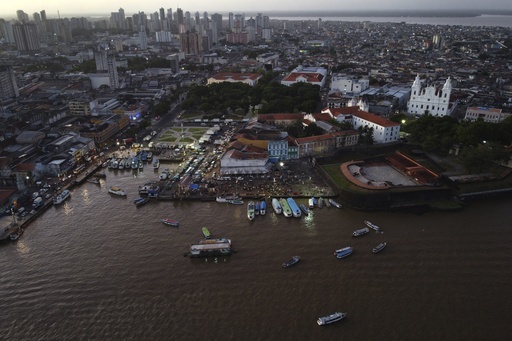
BELEM, Brazil — In recent years, climate experts, advocates, and Brazilian President Luiz Inacio Lula da Silva have highlighted the significance of the first U.N. climate conference to take place in the Amazon rainforest. As the largest tropical forest on the planet, the Amazon is vital in absorbing carbon emissions, thus playing an essential role in combating climate change on a global scale.
The COP30 climate negotiations, set to occur in Belem next year, will be crucial not just for its symbolic significance but also as nations are expected to present enhanced plans for lowering emissions. However, the picturesque image of a vibrant forest may not be what attendees find upon their arrival. Belem, home to about 2.5 million residents, grapples with severe poverty, crime, and social inequalities, with only 2% of its sewage being appropriately treated, negatively impacting its 14 river basins.
Since Belem was chosen to host COP30 two years ago, the city has been making significant preparations. Construction barriers marked with “COP30” signs have appeared throughout various districts, and three major hotels are under construction. Even with these new facilities, there won’t be enough accommodations, prompting organizers to consider utilizing cruise ships to house up to 5,000 attendees. Brazilian authorities anticipate that approximately 50,000 people, including around 150 heads of state, will participate in the climate summit.
This conference will also be a critical moment for Lula’s pledge to protect the Amazon. Following his election for a third term in 2022, he garnered support for his commitment to reversing the sharp rise in deforestation that occurred under the previous far-right administration of President Jair Bolsonaro. Although Lula’s government has effectively curtailed forest destruction, he has also shown interest in controversial projects, such as large-scale oil exploration at the Amazon River’s mouth and creating a highway through some of the most pristine areas of the rainforest.
In the face of these challenges, the state government of Para has initiated around 30 infrastructure projects focused on urban development and boosting tourism. Among the largest is Parque da Cidade, a 123-acre park built on a former airfield. Once utilized for the COP, it will transform into a public space featuring a museum, dining options, and recreational paths. This initiative is being executed by Vale, a mining company linked to two of Brazil’s most significant environmental disasters due to dam collapses in 2015 and 2019, which resulted in numerous fatalities and environmental damages.
The Para government has noted that local regulations permit mining firms to pay a portion of their fees through public projects. Vale is reportedly complying with existing environmental laws while running one of the world’s largest iron ore mines in the Amazon region.
Belem, however, has consistently ranked among Brazil’s most dangerous cities, marked by pervasive organized crime and violent militia activity. Such conditions lead residents to share stories of theft and other criminal incidents. Enhanced security measures are being adopted for the conference, involving the military and local law enforcement.
Despite its struggles, Belem is accustomed to managing large events, as showcased during the Procession of Our Lady of Nazareth, one of the biggest religious celebrations in Latin America, which attracted around 2 million attendees without major incidents. Brazil’s history of hosting significant international gatherings, like the 2014 World Cup and the 2016 Summer Olympics, speaks to its capability in managing events on such a scale.
One river in Belem, the Tucunduba, highlights the city’s broader environmental challenges. Flowing for nearly three miles before merging with the Guama River, it has become a dumping ground for untreated waste. During a boat tour, journalists reported foul odors, with debris such as abandoned refrigerators littering the river, alongside informal housing built on stilts along its banks. Local resident Fabio Passos reminisced about the river’s former clarity and vitality, illustrating the degradation it has undergone over the decades.
The rapid urbanization in Brazil has led to widespread poverty and a surge in drug-related violence, with 75% of the Amazon’s 28 million population now residing in urban areas. João Maria Garcias, a metalworker residing in a nearby squatter settlement, noted the changing nature of his environment, where locals initially fished in the river before the arrival of informal housing that led to pollution.
In preparation for COP30, the state government is working on a “macro drainage” plan involving the installation of concrete slabs along the riverbanks and improvements to sewage systems. While authorities claim this will help mitigate flooding, critics from a local environmental organization argue it’s more effective to restore natural vegetation and remove concrete barriers to allow the river to flow freely again.
Natasha Reis, a representative from the nonprofit, expressed concern over the diminished relationship locals have with the river. She emphasized the importance of experiencing and valuing the Amazon, especially for future generations, who may only know the river as a polluted waterway rather than a place of life and recreation.
One local resident, Paraguassú Éleres, has made strides in preserving an oasis within the urban landscape. He has maintained clean headwaters by avoiding urban development and promoting ecological education for visitors to explore the river’s sources. As Belem prepares for the COP30 summit, these contrasting narratives—between environmental degradation and community commitment—serve as a telling backdrop to the pressing climate discussions that lie ahead.
